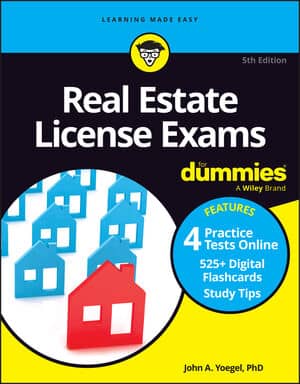Real estate sales contracts indicate a buyer’s and a seller’s agreement to exchange property for (usually) money. The Real Estate License Exam will ask questions about the elements necessary to make a sales agreement valid and enforceable. A sales contract is a bilateral (two people exchanging promises) express (each party states what they’re agreeing to) agreement.
How to make a valid sales contract (and knowing who prepares it)
For a real estate sales contract to be valid, it must comply with the laws of the state where the property is located. Although they may vary slightly by state, the following elements generally are the minimum requirements:
Legally competent parties.
A contract that must be in writing.
A legal description of the property.
Words of mutual agreement to buy and sell the property.
Consideration, or what is being paid or exchanged and any other financial terms.
Signatures of both (or all) parties. The signing of a contract for the sale of a property gives the buyer equitable title, which isn’t yet ownership and which can be conveyed only by a deed. Instead, it’s a contract right that essentially gives the buyer the right to demand title (ownership) to the property when the agreed-upon price is paid.
Lawful object. This requirement’s usually pretty easy to meet because the object of the real estate sales contract is to sell the real estate.
For exam purposes, you should remember what the elements for a valid contract are and what each of them means.
Extras on sales contracts
Many sales contracts contain information about the type of deed that will be delivered to the buyer, encumbrances on the title, any money being deposited as part of the agreement, a statement of what constitutes evidence of good title, a date and place of closing, what happens in the event of destruction of the property before the closing, and other terms and conditions of the sale.
You need to check out what, if any, laws exist in your state with respect to the consequences of destruction of the property.
One element that typically appears in a sales contract is a contingency clause, or a statement that requires that a specified condition must be met for the contract to be completed. Typical conditions in a real estate sales contract are a mortgage or financing contingency and an inspection contingency.
A mortgage contingency allows for the possibility that the buyer may not be able to afford to buy the house. Upon agreeing to purchase a house for $200,000 and coughing up $25,000 in cash for a down payment, the buyer plans to borrow the rest through a mortgage loan.
Because the sale can’t go through unless the buyer can borrow the full $175,000, the buyer puts a clause in the contract that enables him or her the option of getting out of the deal if the lender refuses to approve an adequate mortgage loan amount. Without the mortgage contingency in the contract of sale, the buyer can lose the down payment, if the purchase doesn’t go through as planned.
An inspection contingency, on the other hand, is an agreement that requires an inspection of the house by a home inspector. The house must pass the inspection. If this contingency clause is included in the contract, the buyer can get out of the deal if the inspector finds something wrong with the house and the seller refuses to repair it.
A third contingency that you may see is one in which the buyer must be permitted to sell his current home before being forced to buy the new home. This contingency protects the buyer from owning and having to pay mortgages on two homes at the same time.
Going back and forth with offer and acceptance
Generally this process of negotiation follows the pattern of the seller listing the house for sale, the buyer making an offer to buy the house, the seller coming back with a counteroffer for the buyer, the buyer making a counteroffer to the seller’s counteroffer, and acceptance by the seller with as many counteroffers as needed for the two parties to come to a meeting of the minds, or mutual assent.
An exam question on the offer and acceptance process may present a case of buyer and seller going back and forth and ask you if a particular offer is binding. Remember that as soon as a seller counteroffers to a buyer’s offer, the buyer’s offer no longer exists.
A binder, or offer to purchase, may be the first step toward solidifying a deal in some parts of the country, in different parts of the same state, and, in recent years, among different brokers in the same market area. A binder is used for residential real estate. A similar agreement, called a letter of intent, is used in commercial real estate transactions.
A binder is used primarily to signify that a deal has been made and an agreement has been reached to go forward with more formal contract negotiations. At the point at which there’s an accepted offer, the binder is signed by both buyer and seller. A binder often is accompanied by an earnest money deposit or down payment to signal the buyer’s seriousness in going forward with the purchase.

